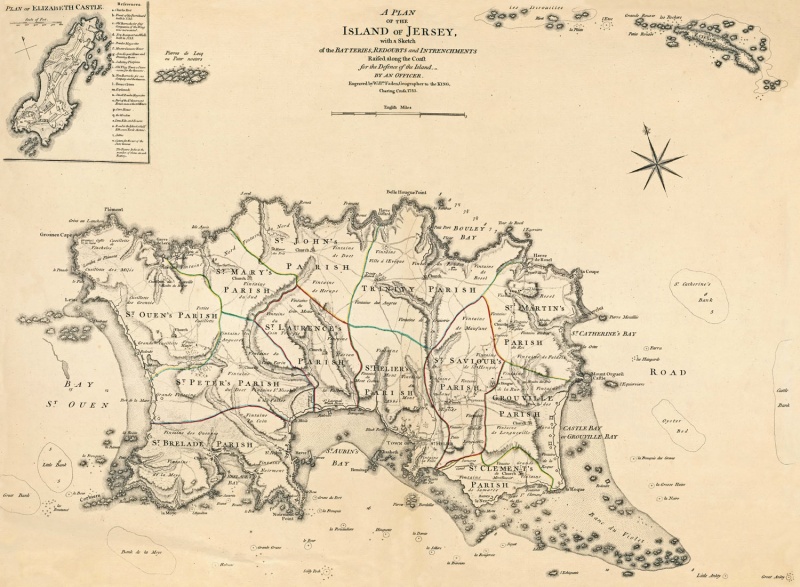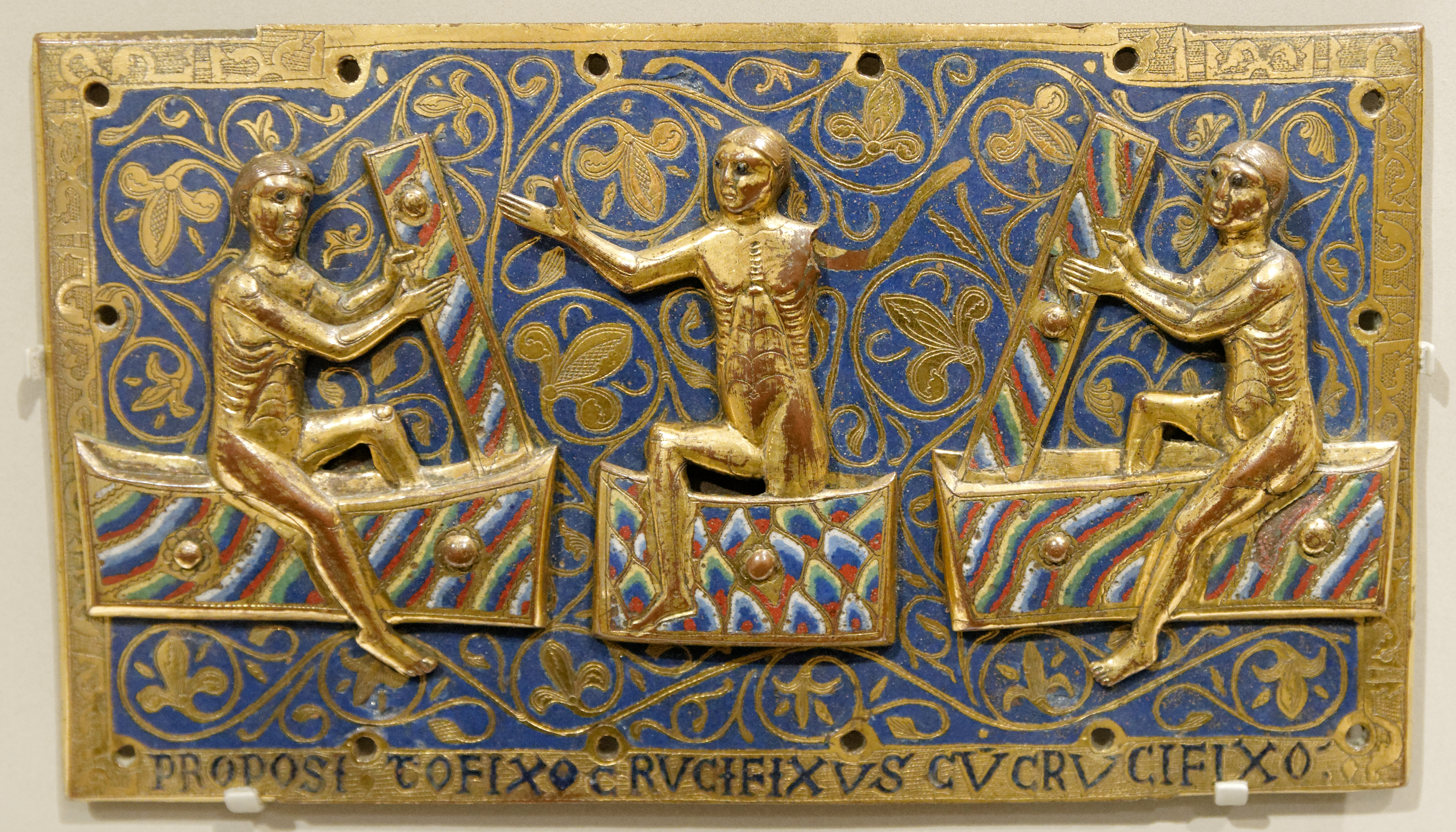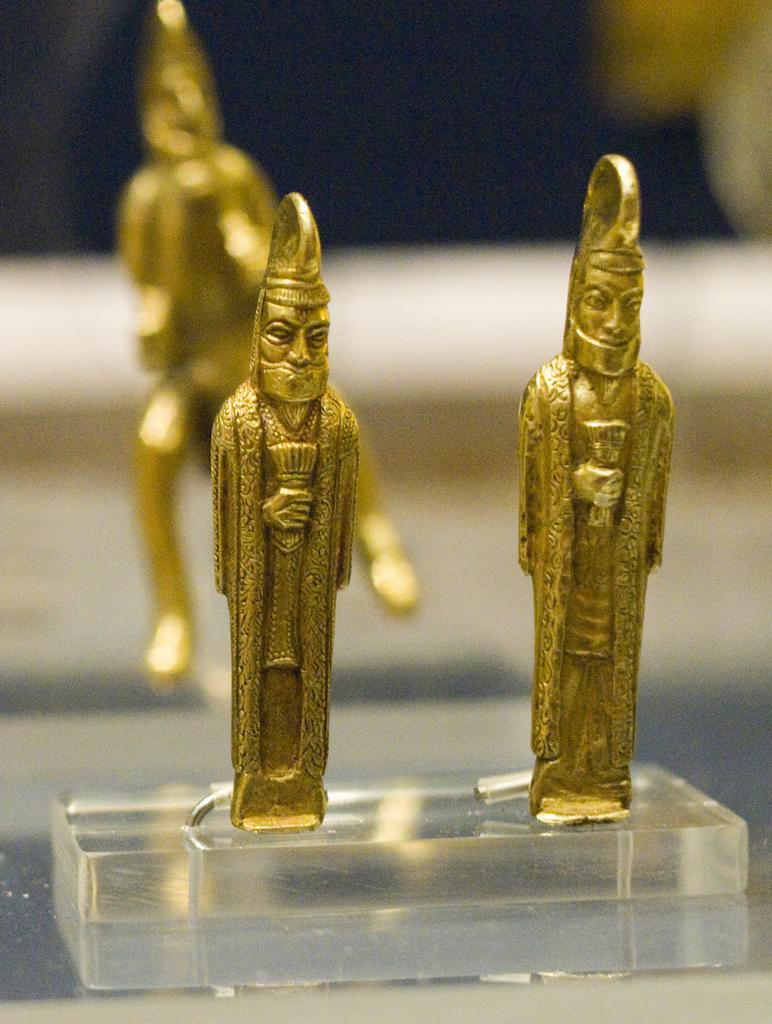|
Fisherman's Chapel
The Fishermen's Chapel (french: Chapelle-ès-Pêcheurs, Jèrriais: Chapelle ès Pêtcheurs) is a small chapel located beside St Brelade's Church in St Brelade, Jersey, by the shore at the western end of St Brelade's Bay. History Only a few medieval chapels survived the destruction of over fifty others at the hands of the Reformers in the 16th century. This is one of the few remaining with the exception of some Manorial Chapels, and those at La Hougue Bie. The name of the chapel is the Chapelle-ès-Pêcheurs, and it was originally thought to be associated with the fishing guilds said to have existed in the Island. More convincingly, Warwick Rodwell has suggested that "pêcheurs" (fishermen) is a corruption of " pécheurs" (sinners); this agrees with his archaeological investigations which show the chapel to have been a "chantry chapel", i.e. a chapel funded by a local family to say masses for the souls of the dead. There is no evidence of "fishing guilds". The walls of this anci ... [...More Info...] [...Related Items...] OR: [Wikipedia] [Google] [Baidu] |
Chapelle ès Pêtcheurs C
Chapelle or La Chapelle may refer to: Communes in France * La Chapelle, Allier * La Chapelle, Ardennes * La Chapelle, Charente * La Chapelle, Savoie * Les Chapelles, Savoie department Other places * Église de la Chapelle or Kapellekerk, a church in Brussels * Quartier de La Chapelle, a neighborhood of Paris, France * La Chapelle (Paris Metro), a metro station in Paris, France * Porte de la Chapelle (Paris Metro), a metro station in Paris, France * Sainte-Chapelle, a Gothic chapel on the Île de la Cité, Paris, France * La Chapelle, Artibonite, a commune in Artibonite department, Haiti * La Chapelle, a commune of Plan-les-Ouates, Switzerland * Chapelle, Glâne, a municipality of the canton of Fribourg, Switzerland * Archbishop Chapelle High School, a high school in New Orleans, United States * Aix-la-Chapelle or Aachen, Germany Other uses * La Chapelle (Church), a Baptist Evangelical multi-site church based in Montreal, Canada. *Chapelle (surname) *Chapelle Jewellery, a br ... [...More Info...] [...Related Items...] OR: [Wikipedia] [Google] [Baidu] |
Annunciation
The Annunciation (from Latin '), also referred to as the Annunciation to the Blessed Virgin Mary, the Annunciation of Our Lady, or the Annunciation of the Lord, is the Christian celebration of the biblical tale of the announcement by the angel Gabriel to Mary that she would conceive and bear a son through a virgin birth and become the mother of Jesus Christ, the Christian Messiah and Son of God, marking the Incarnation. Gabriel told Mary to name her son Jesus, meaning " YHWH is salvation". According to , the Annunciation occurred "in the sixth month" of Elizabeth's pregnancy with John the Baptist. Many Christians observe this event with the Feast of the Annunciation on 25 March, an approximation of the northern vernal equinox nine full months before Christmas, the ceremonial birthday of Jesus. The Annunciation is a key topic in Christian art in general, as well as in Marian art in the Catholic Church, having been especially prominent during the Middle Ages and Re ... [...More Info...] [...Related Items...] OR: [Wikipedia] [Google] [Baidu] |
History Of Jersey
Jersey is the largest of the Channel Islands, an island group in the English Channel near France. Although not geographically part of the archipelago of the British Isles, politically and culturally the islands are generally accepted as such. The Channel Islands are the last remnants of the medieval Duchy of Normandy that held sway in both France and England. The islands remained loyal to the English crown after the return of Normandy to France in 1204 and have enjoyed self-government since. Jersey and the rest of the Channel Islands are notable for being the only part of the British Isles to be occupied by Nazi Germany during World War II. The most widely regarded history of Jersey is ''Balleine's History of the Island of Jersey'', written by G. R. Balleine in 1959, and later adapted by the Société Jersiaise, most notably two of its members Marguerite Syvret and Joan Stevens. Name of the island Although Jersey was part of the Roman world, there is a lack of evidence to gi ... [...More Info...] [...Related Items...] OR: [Wikipedia] [Google] [Baidu] |
Buildings And Structures In Saint Brélade
A building, or edifice, is an enclosed structure with a roof and walls standing more or less permanently in one place, such as a house or factory (although there's also portable buildings). Buildings come in a variety of sizes, shapes, and functions, and have been adapted throughout history for a wide number of factors, from building materials available, to weather conditions, land prices, ground conditions, specific uses, prestige, and aesthetic reasons. To better understand the term ''building'' compare the list of nonbuilding structures. Buildings serve several societal needs – primarily as shelter from weather, security, living space, privacy, to store belongings, and to comfortably live and work. A building as a shelter represents a physical division of the human habitat (a place of comfort and safety) and the ''outside'' (a place that at times may be harsh and harmful). Ever since the first cave paintings, buildings have also become objects or canvasses of much artistic ... [...More Info...] [...Related Items...] OR: [Wikipedia] [Google] [Baidu] |
Société Jersiaise
The Société Jersiaise is a learned society in Jersey which was founded in 1873, in the manner of similar county societies in the United Kingdom and Sociétés Savantes in France for the purposes of: *''"The Publication of Local History, *''The encouragement of the use of French, the official language'', *''The study of the ancient local dialect'', *''To achieve, as far as possible, the conservation of all prehistoric and historical sites'', *''To found a library, mainly historical and archaeological'', *''To collaborate with other societies with similar aims''" The Société continues to fulfill these objectives, with two important differences – because it can no longer be said that French is the official language, the encouragement of its use has been dropped and, secondly, an important addition to the aims is the study of all branches of the natural history of the island and publication of the results of fieldwork in these subjects. By 1878 a museum had been formed. ... [...More Info...] [...Related Items...] OR: [Wikipedia] [Google] [Baidu] |
Brelade
Branwalator or Breward, also referred to as Branwalader, was a British saint whose relics lay at Milton Abbas in Dorset and Branscombe in Devon. Believed to come from Brittany, he also gives his name to the parish of Saint Brélade, Jersey. "Brelade" is a corruption of "Branwalader". He is also known as ''Breward'' or ''Branuvelladurus'' or Brélade and Broladre in French. Life Branwalator was a British monk, who is said to have been a bishop in Jersey, although at the time, Jersey would have been part of the ancient diocese of Dol. As with many of the early saints of this part of the world, it is difficult to separate fact from fiction. However, it is believed that Branwalator worked with Saint Samson in Cornwall and the Channel Islands, where he is remembered in Jersey in the parish name St Brelade and at Cornwall in the parish name of St Breward. He may also have travelled with Samson to Brittany in northern France. In the Exeter martyrology, Branwalator is described as ... [...More Info...] [...Related Items...] OR: [Wikipedia] [Google] [Baidu] |
Saint Brendan
Brendan of Clonfert (c. AD 484 - c.577), is one of the early Irish monastic saints and one of the Twelve Apostles of Ireland. He is also referred to as Brendan the Navigator, Brendan the Voyager, Brendan the Anchorite, Brendan the Bold. The Irish translation of his name is Naomh Bréanainn or Naomh Breandán. He is mainly known for his legendary voyage to find the “Isle of the Blessed” which is sometimes referred to as “Saint Brendan’s Island”. The written narrative of his journey comes from the immram The Navigatio Sancti Brendani Abbatis (Voyage of Saint Brendan the Abbot). Saint Brendan's feast day is celebrated on 16 May by Catholics, Anglicans, and Orthodox Christians. Sources There is very little secure information concerning Brendan's life, although at least the approximate dates of his birth and death, and accounts of some events in his life, are found in Irish annals and genealogies. The earliest mention of Brendan is in the ''Vita Sancti Columbae'' (Li ... [...More Info...] [...Related Items...] OR: [Wikipedia] [Google] [Baidu] |
Adam And Eve
Adam and Eve, according to the creation myth of the Abrahamic religions, were the first man and woman. They are central to the belief that humanity is in essence a single family, with everyone descended from a single pair of original ancestors. They also provide the basis for the doctrines of the fall of man and original sin that are important beliefs in Christianity, although not held in Judaism or Islam. In the Book of Genesis of the Hebrew Bible, chapters one through five, there are two creation narratives with two distinct perspectives. In the first, Adam and Eve are not named. Instead, God created humankind in God's image and instructed them to multiply and to be stewards over everything else that God had made. In the second narrative, God fashions Adam from dust and places him in the Garden of Eden. Adam is told that he can eat freely of all the trees in the garden, except for a tree of the knowledge of good and evil. Subsequently, Eve is created from one of Ada ... [...More Info...] [...Related Items...] OR: [Wikipedia] [Google] [Baidu] |
Last Judgement
The Last Judgment, Final Judgment, Day of Reckoning, Day of Judgment, Judgment Day, Doomsday, Day of Resurrection or The Day of the Lord (; ar, یوم القيامة, translit=Yawm al-Qiyāmah or ar, یوم الدین, translit=Yawm ad-Dīn, label=none) is part of the Abrahamic religions and the '' Frashokereti'' of Zoroastrianism. Christianity considers the Second Coming of Jesus Christ to entail the final judgment by God of all people who have ever lived, resulting in the approval of some and the penalizing of others. The concept is found in all the canonical gospels, particularly in the Gospel of Matthew. The Christian tradition is also followed by Islam, where it is mentioned in the 43rd chapter ('' Az-Zukhruf'') of the Quran, according to some interpretations. Christian futurists believe it will follow the resurrection of the dead and the Second Coming of Jesus, while full preterists believe it has already occurred. The Last Judgment has inspired numerous artistic ... [...More Info...] [...Related Items...] OR: [Wikipedia] [Google] [Baidu] |
Resurrection
Resurrection or anastasis is the concept of coming back to life after death. In a number of religions, a dying-and-rising god is a deity which dies and is resurrected. Reincarnation is a similar process hypothesized by other religions, which involves the same person or deity coming back to live in a different body, rather than the same one. The resurrection of the dead is a standard eschatological belief in the Abrahamic religions. As a religious concept, it is used in two distinct respects: a belief in the resurrection of individual souls that is current and ongoing ( Christian idealism, realized eschatology), or else a belief in a singular resurrection of the dead at the end of the world. Some believe the soul is the actual vehicle by which people are resurrected. The death and resurrection of Jesus is a central focus of Christianity. Christian theological debate ensues with regard to what kind of resurrection is factual – either a ''spiritual'' resurrection ... [...More Info...] [...Related Items...] OR: [Wikipedia] [Google] [Baidu] |
Melchior
Melchior is the name traditionally given to one of the biblical Magi appearing in the Gospel of Matthew. There are many notable people with this name, or close variations. As a first name * Melchior Anderegg (1828–1914), Swiss mountain guide * Melchior Berri (1801–1854), Swiss architect * Melchior Broederlam (c. 1350 – after 1409), Dutch painter * Melchior Cano (1525–1560), Spanish theologian * Melchior Cibinensis, 16th century Hungarian alchemical writer * Melchior Goldast (1576–1635), Swiss writer * Melchior d'Hondecoeter (1636–1695), Dutch animalier * Melchior de Polignac (1661–1742), French diplomat, Roman Catholic cardinal * Melchior de Vogüé (1848–1910), French diplomat, travel writer, archaeologist, philanthropist * Melchior Franck (1579–1639), German composer * Melchior Grodziecki (1584–1619), Catholic saint * Melchior Hoffman (c. 1495–1543), German-Dutch Anabaptist prophet * Melchior Inchofer (c. 1584–1648), Jesuit who took part in Galileo's ... [...More Info...] [...Related Items...] OR: [Wikipedia] [Google] [Baidu] |
Magi
Magi (; singular magus ; from Latin '' magus'', cf. fa, مغ ) were priests in Zoroastrianism and the earlier religions of the western Iranians. The earliest known use of the word ''magi'' is in the trilingual inscription written by Darius the Great, known as the Behistun Inscription. Old Persian texts, predating the Hellenistic period, refer to a magus as a Zurvanic, and presumably Zoroastrian, priest. Pervasive throughout the Eastern Mediterranean and Western Asia until late antiquity and beyond, ''mágos'' (μάγος) was influenced by (and eventually displaced) Greek '' goēs'' (γόης), the older word for a practitioner of magic, to include astronomy/astrology, alchemy, and other forms of esoteric knowledge. This association was in turn the product of the Hellenistic fascination for Pseudo-Zoroaster, who was perceived by the Greeks to be the Chaldean founder of the Magi and inventor of both astrology and magic, a meaning that still survives in the modern-day ... [...More Info...] [...Related Items...] OR: [Wikipedia] [Google] [Baidu] |





